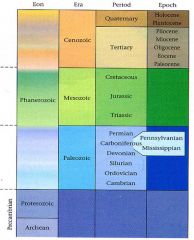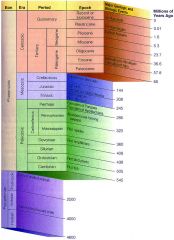![]()
![]()
![]()
Use LEFT and RIGHT arrow keys to navigate between flashcards;
Use UP and DOWN arrow keys to flip the card;
H to show hint;
A reads text to speech;
19 Cards in this Set
- Front
- Back
|
principle of uniformitarianism
|
Processes operating today operated throughout geologic time
Rate or scale may be different |
|
|
principle of original horizontality
|
Layers of sediment are generally deposited horizontally
If folded, implies some sort of crustal disturbance (e.g. folding) |
|
|
law of superposition
|
In an undeformed (flat-lying) sequence of sedimentary rocks, each bed is older than the one above and younger than the one below
|
|
|
principle of lateral continuity
|
Sediment extends laterally until it thins to zero or it gradually changes composition
|
|
|
principle of inclusions
|
Inclusions, or fragments of a previously existing rock contained within a layer of another, are older than the rock in which they have been incorporated
Conglomerate containing rock fragments - fragments are older than the conglomerate Xenolith - older than the igneous intrusion in which they are contained |
|
|
principle of cross-cutting relationships
|
Igneous intrusions (dikes, sills, batholiths) or faults must be younger than the rocks it intrudes or displaces
“truncates or cuts across an older rock” They must form more recently than the rocks through which they pass or cross-cut |
|
|
princple of fossil succession
|
“fossil organisms succeed one another by a definite & determinable order, therefore any time period can be recognized by its fossil contents”
Fossils preserved within the lower layers are older (lived and died before) than those in the overlying layers Order of change in fossils was consistent and could be predicted on the basis of preliminary study Used to correlate layers with similar fossil contents 1. Life has varied through time 2. Fossil assemblages are recognizably different from one another 3. Relative ages of fossil assemblages can be determined 4. Overall, life forms get more complex through time. |
|
|
contacts
|
Conformable contact
Contact between layers of rock deposited without interruption No missing time Unconformity There is a marked discordance between the rocks below and the rocks above the unconformity Missing time There are 3 types: Angular unconformity Disconformity Nonconformity |
|
|
disconformity
|
type of unconformity
Disconformity an erosional surface separating 2 sequences (of very different ages), both of which are parallel to the erosional surface Orientation above and below are the same May resemble bedding plane Use fossils/radiometric dates to determine amount of hiatus |
|
|
nonconformity
|
type of unfconformity
Nonconformity Surface separating crystalline rocks (igneous or metamorphic) from sedimentary rocks Previously existing rocks that were removed by erosion include: All rocks into which the igneous rock intruded Additionally some of the igneous rocks (rocks show clear evidence of weathering and alteration) |
|
|
principle of uniformitarianism
|
Processes operating today operated throughout geologic time
Rate or scale may be different |
|
|
principle of original horizontality
|
Layers of sediment are generally deposited horizontally
If folded, implies some sort of crustal disturbance (e.g. folding) |
|
|
law of superposition
|
In an undeformed (flat-lying) sequence of sedimentary rocks, each bed is older than the one above and younger than the one below
|
|
|
principle of lateral continuity
|
Sediment extends laterally until it thins to zero or it gradually changes composition
|
|
|
principle of inclusions
|
Inclusions, or fragments of a previously existing rock contained within a layer of another, are older than the rock in which they have been incorporated
Conglomerate containing rock fragments - fragments are older than the conglomerate Xenolith - older than the igneous intrusion in which they are contained |
|
|
angular unconformities
|
An erosional surface separating beds inclined to the unconformity from other beds parallel to it
Distinctly different orientation above & below Underlying rocks were uplifted, tilted and eroded, and then younger materials were deposited on the erosional surface |
|
|
correlation
|
Demonstration of time equivalency of rock units in different areas
Recognized by William Smith in the early 1800’s Trace laterally (principle of lateral continuity) Similarity of rock types & fossil content, especially index fossils Position in the sequence Key beds - marker horizon (ash beds & coal beds) |
|
|
relative time scale
|

Hierarchical scale in which 4.6 billion history of the Earth is subdivided into time units of varying duration
|
|
|
two relative time scales
|

|

